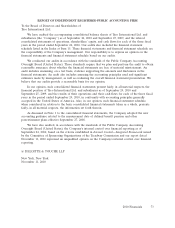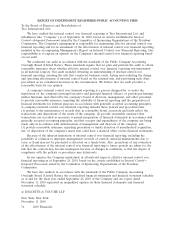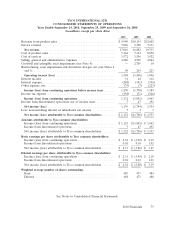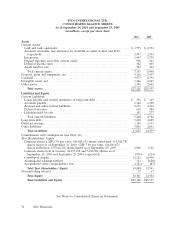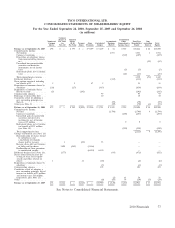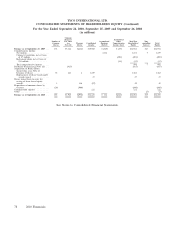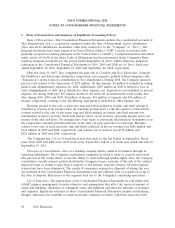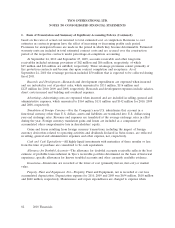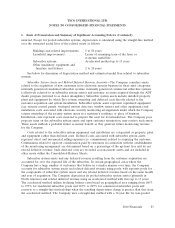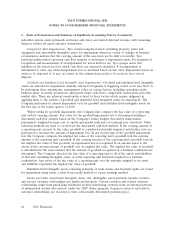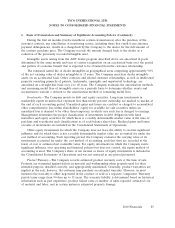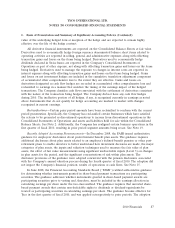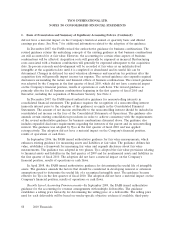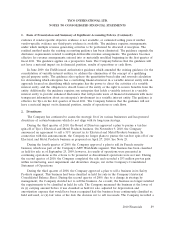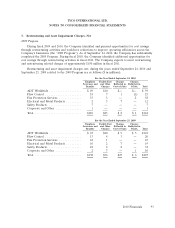ADT 2010 Annual Report Download - page 171
Download and view the complete annual report
Please find page 171 of the 2010 ADT annual report below. You can navigate through the pages in the report by either clicking on the pages listed below, or by using the keyword search tool below to find specific information within the annual report.TYCO INTERNATIONAL LTD.
NOTES TO CONSOLIDATED FINANCIAL STATEMENTS
1. Basis of Presentation and Summary of Significant Accounting Policies (Continued)
incurred. Except for pooled subscriber systems, depreciation is calculated using the straight-line method
over the estimated useful lives of the related assets as follows:
Buildings and related improvements . . 5 to 50 years
Leasehold improvements .......... Lesser of remaining term of the lease or
economic useful life
Subscriber systems .............. Accelerated method up to 15 years
Other machinery, equipment and
furniture and fixtures ........... 2 to 20 years
See below for discussion of depreciation method and estimated useful lives related to subscriber
systems.
Subscriber System Assets and Related Deferred Revenue Accounts—The Company considers assets
related to the acquisition of new customers in its electronic security business in three asset categories:
internally generated residential subscriber systems, internally generated commercial subscriber systems
(collectively referred to as subscriber system assets) and customer accounts acquired through the ADT
dealer program (referred to as dealer intangibles). Subscriber system assets include installed property,
plant and equipment for which Tyco retains ownership and deferred costs directly related to the
customer acquisition and system installation. Subscriber system assets represent capitalized equipment
(e.g. security control panels, touchpad, motion detectors, window sensors and other equipment) and
installation costs associated with electronic security monitoring arrangements under which the Company
retains ownership of the security system assets in a customer’s residence or place of business.
Installation costs represent costs incurred to prepare the asset for its intended use. The Company pays
property taxes on the subscriber system assets and upon customer termination, may retrieve such assets.
These assets embody a probable future economic benefit as they generate future monitoring revenue
for the Company.
Costs related to the subscriber system equipment and installation are categorized as property, plant
and equipment rather than deferred costs. Deferred costs associated with subscriber system assets
represent direct and incremental selling expenses (i.e. commissions) related to acquiring the customer.
Commissions related to up-front consideration paid by customers in connection with the establishment
of the monitoring arrangement are determined based on a percentage of the up-front fees and do not
exceed deferred revenue. Such deferred costs are recorded as non-current assets and are included in
other assets within the Consolidated Balance Sheets.
Subscriber system assets and any deferred revenue resulting from the customer acquisition are
accounted for over the expected life of the subscriber. In certain geographical areas where the
Company has a large number of customers that behave in a similar manner over time, the Company
accounts for subscriber system assets and related deferred revenue using pools, with separate pools for
the components of subscriber system assets and any related deferred revenue based on the same month
and year of acquisition. The Company depreciates its pooled subscriber system assets (primarily in
North America) and related deferred revenue using an accelerated method with lives up to 15 years.
The accelerated method utilizes declining balance rates based on geographical area ranging from 160%
to 195% for residential subscriber pools and 145% to 265% for commercial subscriber pools and
converts to a straight-line methodology when the resulting depreciation charge is greater than that from
the accelerated method. The Company uses a straight-line method with a 14-year life for non-pooled
2010 Financials 83


